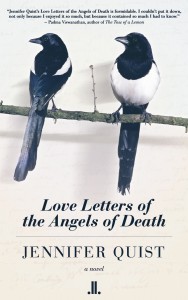 The AML Online Book Club, on March 19, 7pm Mountain time, will discuss Jennifer Quist’s novel Love Letters of the Angels of Death, which is one of the AML 100 Works of Significant Mormon Literature, and one of the best LDS-related novels of the 21st century. Jennifer will join us to answer questions about the book. All are welcome. Please ask to attend in the replies, and we will send you the Zoom link.
The AML Online Book Club, on March 19, 7pm Mountain time, will discuss Jennifer Quist’s novel Love Letters of the Angels of Death, which is one of the AML 100 Works of Significant Mormon Literature, and one of the best LDS-related novels of the 21st century. Jennifer will join us to answer questions about the book. All are welcome. Please ask to attend in the replies, and we will send you the Zoom link.
Below are some reviews of the 2013 novel, and then excerpts from an AML interview that Jennifer did with Michael Austin in 2018 after her second novel, Sistering, won the AML Novel Award.
Jennifer Quist is an award-winning novelist in Alberta, Canada. Besides her novels Love Letters of the Angels of Death (2013), Sistering (2015), and The Apocalypse of Morgan Turner (2018), she also writes short fiction, journalism, criticism, and translations, and edits the fiction section of Dialogue: A Journal of Mormon Thought. She is in the doctoral program of Comparative and Transnational Literatures at the University of Alberta, and just this week she successfully defended her PhD dissertation.
Reviews of Love Letters of the Angels of Death
Kellie, Segullah. “Love Letters of the Angels of Death is (contrary to the Gothic-sounding title) a lyrical, rich love story between a husband and wife. The characters are full-blooded, incredibly vibrant and above all firmly, undeniably relatable . . . The wife is pregnant in several of the stories told, they argue, sneak kisses when the kids aren’t watching, they each have their pet peeves and morbid fascinations. What they have is each other, and an obviously deep, committed relationship which is their support and anchor through ordinary, difficult, crushingly difficult experiences . . . This is a gorgeous, beautiful piece of lyrical realism.”
Publishers Weekly: “Cheerfully unsentimental, the work manages a surprising joyful tone for a novel obsessed with inexorable death, with the idea that to be born is to take the first step towards the grave. Told in the second person, the work is a song of praise to mono no aware, the pathos of transience. It nevertheless celebrates the sweet moments in life along with the bitter. It reminds readers that life is short but along the way are moments that can make it worthwhile, if one only takes the time to appreciate them. A striking examination of life and death, the work is a promising debut novel.”
National Post. “For all this dwelling on mortality, Love Letters of the Angels of Death can be quite perky, mostly because of the personality of Caroline. She’s feisty without being obnoxious, stubborn without being politically correct . . . [The novel] is powered rather by vivid set pieces — a horrific dental procedure, a frightening injury suffered by their two-year-old son on a merry-go-round. It is rather a series of linked stories with a very strong thematic unity — and very strong unity of tone — than a novel. Quist’s heroine, in particular, has a sardonic edge to her speech, as well as an eye for what makes a culture function. Her metaphors, it is interesting to note, are never from the natural world but from the world of literature and media, with references ranging from the Bible to Joni Mitchell. Quist’s prose, finally, is painstaking in its effort to capture the tangible and the olfactory as well as the visual.”
Theric Jepson, A Motley Vision. “This is a woman writing as a man writing to a woman, which creates a layer to the fictional couple’s relationship that allows me to listen to the man’s words without feeling oppressive . . . She writes men extremely well. I certainly see myself in the “part of my unconscious mind that hears the little cries in the night and sleeps on and on—fat, loathsome, and fatherly in a way that’s more reptile than it is human” (39) . . . Love Letters of the Angels of Death is my new go-to novel on issues of matrimony and mortality, and the volume I’m most likely to shove into the hands of anyone who does not think those inseparable.” Theric later said, “This is my favorite book read in 2014. Without serious competition.”
Quill & Quire. “The second-person-inside-the-first becomes the overarching leitmotif of the book. While never overtly addressing the reader, this approach suggests we’re being engaged as a kind of substitute spouse, with all the intimacy that implies . . . The author takes refreshing risks with the metaphoric potential of narrative voice: the wifely “you,” sometimes awkwardly sustained, nonetheless seems to be gathering toward some kind of revelation. That climactic moment arrives with mixed success, but conveys a heartfelt authorial grasp of life’s losses. Quist drives home her theme: husband and wife – Brigham and “you” – engage with the macabre, sorrowful aspects of mortality on almost every page. Happily, Brigham’s voice is marked by a gently jaded irony that’s free of pathos. Flashbacks to the couple’s feisty courtship, nuptials, and the raising of three sons bring the fractious pleasures of living back into the mix. Love Letters of the Angels of Death gains resonance in retrospect. Quist’s subject is the paradoxical connection and division between self and other, and how love narrows the gap while making final separation the painful, inevitable counterpoint.”
The Indiscriminate Critic. “As much as the experience and knowledge of death is central to the novel, this is equally a story about the marital relationship between Brigs and his wife. The authenticity of the small, shared moments took me quite by surprise, and made my enjoyment more personal than abstract. . . . Quist’s literary style comes across as effortless while retaining a keen edge of precision. I was simply astounded at how easily I became engrossed in the book. I’m also a big sucker for allusions and recurring thematic elements, and Love Letters of the Angels of Death is simply stacked in that respect. Two of the most outstanding examples were the Niagara Falls mummy, whose repeated mention married the notion of human remains with a dash of Canadiana, and the notion of the incorruptible saints, which artistically blurred the line between the corporal and spiritual. When Elijah was mentioned—the Hebrew prophet who was taken from the earth before he died—it was to me like putting a cherry on top of an already rich confection. Beyond the prose itself, I was also quite taken with the unique elements of style and story. A mental Möbius strip developed from trying to wrap my mind around the fact that this is a woman writing as a man writing about a woman. There was also an almost dislocated effect arising from having a first person narrator tell the story in second person point of view. And while it might appear that these refractive elements couldn’t possibly work, Quist somehow manages to make it seem as though it couldn’t be written in any other way. The telling of this tale couldn’t possibly be any better. From a personal point of view, I’m tempted to prematurely call this the best book I will read all year. I literally couldn’t pull myself away from the pages, reading it in one uninterrupted sitting. There were moments of gleeful delight where my smile could have lit up a room, and moments of shattering heartache where I felt myself audibly gasp. It hit some personal chord deep inside of me where literature is often unable or unwilling to strike. Apart from being a stunning literary debut, this is a novel that has already found a special place on my bookshelf and in my heart. Highly recommended.”
Shelah Books It. 5 stars. “It sounds like a lot of simple things, but Quist shows (without being sentimental or heavy-handed) that it’s simple moments like these that make up a relationship, that cement a love affair. The writing is beautiful and a little bit haunting (I think it has to do with the perspective), and I found myself riveted. Since a book that focuses so much on death is ultimately a book that also focuses on faith, I was very impressed with the way that Quist handled issues of faith. I think that in books written by Mormons, we often see characters who are overtly Mormon and then seem to be characterized as “Mormon” characters, or we see authors who stay away from issues of religion and faith at all, so they don’t have to address it and possibly limit their audience. To a Mormon reader, Briggs and his wife are obviously LDS, but Quist seems to stick to looking at issues of faith and not necessarily of Mormon culture. Quist’s characters are faithful and mature, but their faith is undefined.”
Rosalyn Eves. “This was a gorgeously written book exploring the close (sometimes constricting) ties between two people who know and love each other intimately. This isn’t a plot driven novel at all, but a character driven one, written as a series of letters (sort of) from husband to wife . . . It took me a while to get into the second-person narration, but once I got past that I found myself engrossed in the story and read it in just a couple of days. It’s a short novel, but a powerful one. I found myself repeatedly slowing down just to enjoy the prose.”
Jessie Christensen. “Reading this book was an experience in falling into another reality for several hours; I didn’t want it to end because I felt like I was getting to know the world, and two particular people, in new and intimate ways. There were so many beautiful passages that left me nodding with agreement at their insight into life–family relationships, marriage, and the tiny details that bind us together. This is the kind of writing I love–layered details that keep my brain working to make connections throughout the book, realistic characters that feel like friends, and a feeling like I am really living in someone else’s life for a time.”
Jennifer Quist interview, by Michael Austin, 2016
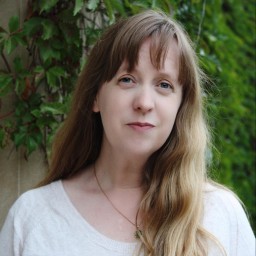 Let’s start with the biographical details. Could you briefly describe your life so far? Start from the beginning and go up to the point that you decided to become a rich and famous writer.
Let’s start with the biographical details. Could you briefly describe your life so far? Start from the beginning and go up to the point that you decided to become a rich and famous writer.
I was born in a remote pulp-mill town in the northern boreal forest. My father was ambitious and restless and moved our family all over the immense country of Canada. By the time I graduated from high school, I had gone to eleven different schools. It would have been lonely if it weren’t for my close sibling group of seven, our ward families, and the grace of God that unfailingly sent me the few good friends I prayed for everywhere we went.
All of this, along with a temporary, treatable hearing loss that went undetected for too long, made my childhood an outsider’s upbringing—difficult but artistically instructive. When I was new in a school, during those long, awkward recesses alone, I would narrate the nothingness into some kind of story in my head—trying to make sense and meaning out of the untold stories of all the people I encountered in media res, out of all the quiet standing on the pavement by myself.
Maybe it sounds bleaker than it was. My siblings and I had the rich, imaginative, unstructured play of kids with no interest in sports. I didn’t notice until third grade that thinking about the world in terms of narratives wasn’t universal—or, at least, wasn’t universally done in the way that I did it. I had a teacher who told me I was talented at writing and I believed her. It was nice to be noteworthy in class for something other than just being new and I probably got hooked on the positive reinforcement like a rat feeding herself food pellets with a lever apparatus. Story-love, story-love, story-love. As in any good operant experiment, writing became its own reward and I reached a point where I would do it whether anyone was reading or not. Still, publication was always my goal.
I like the term that you used, “artistically instructive.” Could you elaborate on this a little bit? Do you think that some life experiences prepare one for writing more than others?
Storytelling is really story re-telling. For me that means the outsider who has never belonged—as opposed to an insider or a former insider—is often the best storyteller. They can be better at observation and expression not only because they don’t take the taken-for-granted for granted but also because they have to pay closer attention and work to be clearly understood in order to survive and be happy in alien landscapes.
Erich Auerbach makes some fascinating comments about the importance of a perspective of exile in dealing with literature and earning “a proper love for the world.” Please bear with me while I mention them without proper citations. Ha! He refers to a quote by Hugo of St. Victor which translates into “He who finds his homeland sweet is still a tender beginner; he to whom every soil is as his homeland is yet stronger; but he is perfect to whom the entire world is a place of exile.” It’s an overstatement of my own feelings but it does speak to my sense that my childhood in exile was an education in seeing, understanding, and learning how to frame and communicate strange worlds as stories.
So, when did you finally decide that you were ready to start submitting your work for publication—or, to use a phrase from Simone de Beauvoir that I have always loved, to “cast yourself into the world” and insist that it pay attention to your words and ideas?
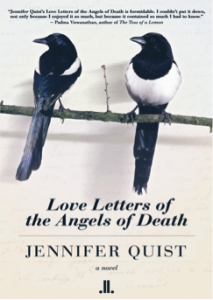 After graduating from university with a degree in sociology (at the time, a literature degree seemed too fanciful) I started a family with my very fine, very broke young husband. From home, I spent about fifteen years writing and publishing non-fiction and a little short fiction and poetry. When my fifth son was fresh out of babyhood, I got serious about novels. I submitted my first “quirky,” risky novel fifty times before finding a publisher on submission 51. It was awful but irresistible—almost like a kind of self-harm. I would stand in the shower crying, praying to be able to stop so the rejections would stop coming and the pain of it would end. And I always got out of the shower feeling calm, and like I could send the manuscript out one more time.
After graduating from university with a degree in sociology (at the time, a literature degree seemed too fanciful) I started a family with my very fine, very broke young husband. From home, I spent about fifteen years writing and publishing non-fiction and a little short fiction and poetry. When my fifth son was fresh out of babyhood, I got serious about novels. I submitted my first “quirky,” risky novel fifty times before finding a publisher on submission 51. It was awful but irresistible—almost like a kind of self-harm. I would stand in the shower crying, praying to be able to stop so the rejections would stop coming and the pain of it would end. And I always got out of the shower feeling calm, and like I could send the manuscript out one more time.
I believe in clumsy little human atonements, subordinate but part of an infinite one—that we’re driven to reach and hold onto each other. I write to overcome distance and isolation, to end separation—no more lonely children on the pavement. Overblown as it may sound, I write for love—the giving and the taking of it–and that means I write not only for myself.
I love that story, and I am so glad you stuck with it. I’m going to guess that one reason it took 51 tries is that your writing doesn’t fit comfortably into any of the standard genre categories, which is also why your books are so amazing. Both of them combine, in extremely interesting ways, light-hearted family comedy with elements of dark tragedy. Sistering has an especially dark plot twist that makes it impossible to forget. Could you briefly describe the corner of your psyche that comes up with these stories?
My father was raised in a house that had been converted from a funeral parlor. His parents were from the dark inland woods of New Brunswick, raised in gloomy Calvinist families with penchants for ghost stories. My spooky roots run deep. When I was thirteen, my father asked me to write down a family story—my grandmother’s story of a miraculous witness of faith she had at her baptism in the Saint John River—and from there I took especial note of all our legends. I’m a keeper of our family lore but, as I’ve remarked in interviews before, I’m a bad keeper who corrupts our history with my own fiction.
Also while we were kids living in the old eastern part of the country, we were often taken to cemeteries to look for graves to fill gaps in our genealogy. Even now I’m still very involved in family history work. As a sickly child (in addition to my brush with hearing loss I grew up with a kidney disease) my mortality was probably closer to the forefront than it might have been for other kids. I needed to shake hands with it at an early age. Family history work is an excellent way to do that, though it does darken the imagination when it comes to fiction. Fortunately, family history comes with lovely redemptive remedies for darkness bundled within it.
One of the other remarkable things about Sistering is that each of the five sisters narrates a portion of the story in her own, unique voice—sometimes even contradicting, or at least reframing, the descriptions of the other narrators. This gives it a richness of perspective that most books lack. Did the book start out to have these multiple perspectives, or did you come to it during the writing process?
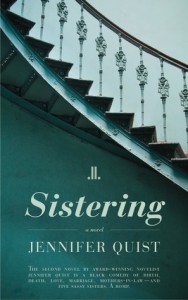 The first draft was written with a narration in the first person by Suzanne alone. The intent was that what she didn’t know about her sisters’ lives she would confabulate, the way I think we tend to do with people we know very well. My publisher—the same one that hadn’t balked when I wrote my first novel in the second person—said it was asking a bit too much of readers. If I couldn’t convince her, I likely couldn’t convince anyone so I went back and completely reworked the story including sharing the point of view among five narrators and the single, collective voice that narrates the last chapter. To tune the voices, I read each sister’s chapters as uninterrupted stories from beginning to end. The split narrative was more challenging than my first version but I’m satisfied with how it’s turned out.
The first draft was written with a narration in the first person by Suzanne alone. The intent was that what she didn’t know about her sisters’ lives she would confabulate, the way I think we tend to do with people we know very well. My publisher—the same one that hadn’t balked when I wrote my first novel in the second person—said it was asking a bit too much of readers. If I couldn’t convince her, I likely couldn’t convince anyone so I went back and completely reworked the story including sharing the point of view among five narrators and the single, collective voice that narrates the last chapter. To tune the voices, I read each sister’s chapters as uninterrupted stories from beginning to end. The split narrative was more challenging than my first version but I’m satisfied with how it’s turned out.
I suspect that AML readers will be interested in the way that your Mormon background influenced your stories. Neither your characters nor your plots are overtly Mormon (I picked up a few signal markers in Love Letters, but couldn’t even see traces in Sistering), and yet a lot of people, me included, have no problem considering your work “Mormon Literature.” Could you briefly explain how you see your own religious background as influencing your fiction?
The use of “Mormon” is difficult for me. I am from a family of fairly recent converts, most of whom have apostatized. There was a small window of time when my entire extended family was a Mormon family but it ended in my early twenties. My husband’s family is Martin Handcart Company blue-blooded but also heavily beset by apostasy. We don’t live in a Mormon town but in one of Canada’s larger, cosmopolitan cities. Except for two very misfit years of high school, I haven’t spent much time in Mormon towns. I went inside the walls of a Church school for the first time this March when I went to the AML conference [at BYU-Hawaii]. “Mormon,” as I think it may be used by many writer-ly LDS people, is not my culture. I have remained in the Church as most of the people I love have fallen away for reasons that are personal rather than based on family, social, or cultural connections. My Mormonism persists in spite of my family, social, and cultural connections.
It is my background as a faith, a discipline, as my entire heart and soul, but not as my culture. As a religious background it influences my choice of words, allusions, sense of family, approach to death, birth, the body. It influences everything like, oh, let’s presume to borrow the metaphor of leaven. It’s inextricable from the whole loaf that is a complete book. Spiritual inspiration is part of the writing process. Sometimes its influence is very clear. There’s a line in my first novel that readers have repeated back to me more than any other as particularly meaningful. It’s a line I first spoke while teaching a Relief Society lesson, looking for spiritual enlightenment. When writing is good, it’s the same thing.
As you point out, there are fewer of what Jack Harrell might call “tags” in my work. I’ve been reading Harrell’s new book and I appreciate the way he describes these tags as superficial shortcuts, cultural props that stand in place of delving into what truly matters about an LDS worldview. While I agree with Harrell, none of this was on my mind as I wrote my first two novels. I didn’t work under the burden of self-consciousness of which I’ve heard other Mormon writers speak. I never asked myself if I was writing for the mass market or the Mormon niche. I was lucky and free to just write.
Having said all that, I do think there are tags in my work, they’re just out of the usual context and harder to identify. For instance, Sistering includes a scene where a woman dresses another woman’s body for burial. Only a funeral professional or a Relief Society sister could move through the mechanics of a scene like that with any authenticity. And I am no funeral professional.
Of course, I have been called out in mainstream Mormon-y outlets for not being Mormon enough. It’s not just a Utah problem. Even after being a Whitney finalist and an AML Award winner, I can’t convince LDS bookstores in my area, way up here in Canada, to carry my work. I don’t like these attitudes but they do put me at liberty to comment on the Mormon book scene from a position of having nothing to lose.
When I was up for a Whitney Award for my first book, someone mused on Twitter about how he should vote. He wondered if he should vote for the best book by a Mormon in 2013 or for the best Mormon book of 2013. I replied, riffing on the Orson F. Whitney quote that’s supposed to be the mission statement of the Whitney project, that my favourite books of Milton and Shakespeare’s are definitely their Mormon books. There’s got to be middle ground in Mormon lit between Rexburg and outer space, and in those spaces, we need to trust the stories to voices other than those of heartland missionary fish-out-of-water characters. This middle ground is where millions of LDS people live. It’s the future of the Church and, I would wager, of Mormon literature. There’s room for all of us and resistance and protectionism from the Mormon cultural heartland only holds everyone back. I suppose what I’m saying, in what may be an obnoxious, nothing-to-lose kind of way, is I don’t really know how to help readers find the Mormon forest in my or anyone else’s work if they can’t see for the missing conventional Church-tag trees.
Wonderful! I think that “between Rexburg and outer space” might be the best prepositional phrase ever uttered. I hope you make it the title of an essay or a blog post—perhaps even here in the AML blog—discussing the future of Mormon literature (about which I think you 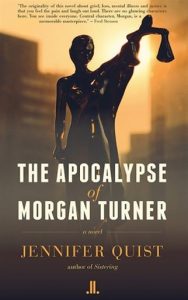 are absolutely correct). One last question, which, I suppose, is obligatory in interviews like these, but I really want to know: what’s your next book going to be about, and are you working on anything else presently? And does this have anything to do with your recent trip to China?
are absolutely correct). One last question, which, I suppose, is obligatory in interviews like these, but I really want to know: what’s your next book going to be about, and are you working on anything else presently? And does this have anything to do with your recent trip to China?
Thanks for asking. The Canada Council for the Arts awarded me a grant this year to finish the first draft of my third novel. It’s another realistic, contemporary family story set in Edmonton where I live. There are Mormons in it as important but not main characters. And there is a little China in it too. Well, it started out with a little China in it. Never approach China intending to come away with only a little bit of anything.
